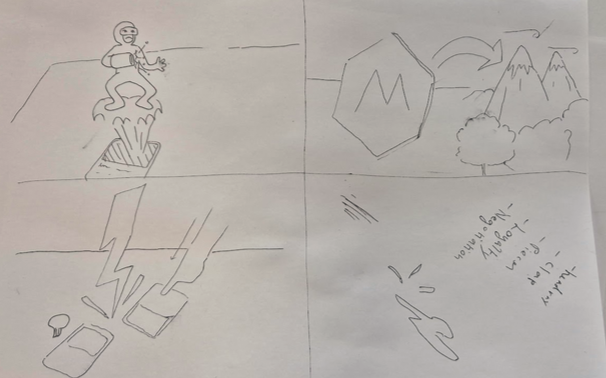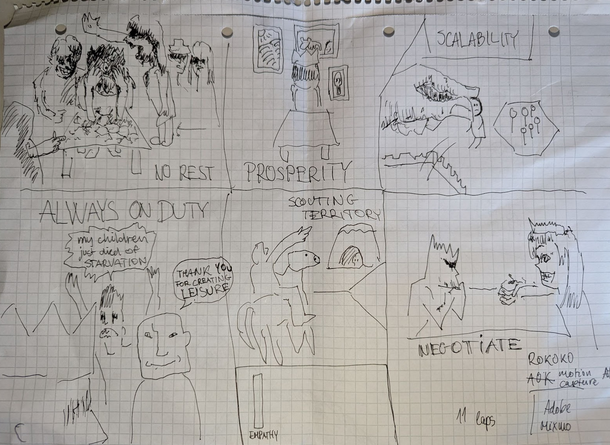Log 2
Game log 2
1. The Wednesday sketching exercise
2. How you converged on your game idea + AR interaction design
- Predominantly through lengthy discussions, boosted by the 6-5-8 Game Sketching.
- Conversations with TAs and expert council.
- Spit balling ideas.
3. Feedback from the Friday's expert council
Council Capture Card
- … What was most exciting for the expert council?
- They loved the idea as a whole, particularly taking interest in the political aspect of the game, which they saw as the essence.
- … What questions emerged from the presentation or council?
- How to trim the fat from the game. They thought it was to expansive and could take multiple years to create.
- … Constructive criticism going forward in cultural gameworld and empowering gameplay?
- The need to involve art pieces more directly 👍
- … New ideas emerging from the presentation or council for creating a stronger game concept regarding culture, games and values.
- Base the game in a concrete time and place, like the roman empire.
- This would allow us to more naturally draw cultural inspiration while still being based in Europe, e.g. you control the last emperor of Rome, Romulus Augustus, who reigned from 475 to 476 AD, fighting monsters from the roman mythology like centaurs.
- Could have a single artwork hanging on the wall as HP, and it changes depending on your level of corruption and the wellbeing of your citizens.
- Maybe cards, like in Monopoly, present the emperor with ultimatums.
- Law cards – tech tree inspired
- Combos when putting down cards
- Generally the idea has become more concrete and a bit smaller. We will be making prototypes over the next week to get an even better feel for what is fun and choice.
Wednesday Sketches

- How cards have a digital presence, consolidating the augmented reality experience
- An idea of how simple hexagonal shapes could create immersive, always-new maps
- Battling by pushing cards together (watching the virtual representation fight). Based on stats.
- Blood splatter and burn marks on the table left. Some notes – reads: hierarchy, clap (turn switch), pieces (instead of cards, but this has different affordances), loyalty (of the people), negotiation.

- Some modes of interaction like pinching to move cards
- Using gaze for group selection (would use headray)
- Hand gestures to see stats of buildings
- Trading when both players to the same hand gestures e.g.
- Using direct manipulation for cards
- Zooming for details
- Not sure
- Head ray.

- Constant pressure from the representatives, that surround the player
- Turning away from the map, the player is presented with their paintings collection, that reflects the current trends / progression of the popolus
- Assigning people to resources by dragging them
- Some contradicting needs of the representatives
- Scouting for resources
- Negotiation for multiplaye
Regarding Expert Council:
1 Introduction => Roles + cultural heritage + EU Values
- Crafter:
- Tell that we share the role of the crafter, meaning that we will all focus on optimizing the game in order to be as efficient as possible, ensuring a smooth gameplay without motion sickness.
- Unit testing for ensuring that each function and the gamplay itself contains as less bugs as possible, ensuring a professional and easily interactivable gameplay.
- Artist:
- That our game should use art to enhance the user experience, focusing on showcasing EU values such as freedom with consequences, but also human dignity being respected or not respected, depending on the dystopic/utopic arts in your environment
- Designer:
- Focuses more on the AR mechanisms implemented in the game, giving the user a natural feeling of embodiment in AR, feeling like you are there and part of the game itself than indirectly manipulating a character outside of the game realm.
2. Game:
In short, our game is a Card War platformer. The user needs a plane surface in the real world to activate the platformer, where the main action happens (Augmented Reality).
The platform is split into 2 sections: the user interaction platform and the adversary, similar to what we see in chess, but the pawns are cards, not figurines.
Cards are buildings that spawn citizens themselves (depending on the building). By clicking virtually on the building, you see the citizens of that building's stats regarding their specific work and environment field, as well as general information such as loyalty, critical thinking, and fear of the kingdom ruler.
Mutual hand gestures for negotiation, platformer changing accordingly, giving the user the possibility of negotiating with the opponent. During negotiation, the user uses a pen (real pen, for example) which can be used to write a specific oral negotiation, such as a peace pact. By writing and then moving the card to the middle of the negotiation table, while both parties agree, the citizens from both kingdoms will understand the message and act based on if they agree or not, deciding to be against by telling you so, or just follow the pact.
(Eventually use the drawings to better articulate the game actions + better understanding for both you and the censors).
2.1 Game as art:
Environmental influence of the game. Given that you look around you, you will observe different paintings that simulate the cumulative feelings your people have towards your decisions. Not only can the paintings either show a dystopic or utopic illustration, but the environment around the game board changes itself accordingly.
By doing this, you can feel what the citizens feel, feeling in our own skin that your decisions are not truely free, the negative emotions and dark atmosphere will likely make you think of another decision, even though you technically have the free will of ruling the kingdom as you wish. Similar to the public pressure of a president given that his decisions are corrupt, unethical or simply against the population ideology and perspective about the situation.
2.2 Game as practical design:
Explained in the game section. The sketches can also be used for better oral articulation.
2.3 Game as a cultural heritage and positive influence:
Well, regarding EU values, we focus on both Freedom but also Human Dignity. Freedom, as explained before, it’s because the player will understand what freedom really means, not only your own freedom of making decisions, but also how your decisions affect the population's freedom of living in a healthy environment.
Human Dignity is about respecting humans’ lives and integrity. Regarding our game, the focus is more on acknowledging that the population is of multiple people with different opinions. This is represented by the cards used, where each card represent specific buildings having each their own communities of people living and working in specific socio-cultural environemts, therefore having different perspectives about the world.
The game itself is an Adventure/Puzzle, where the actual puzzle is in thinking of specific “tactical moves” in order to win the game by evolving as much as possible, both you and the civils, at the same time as keeping a healthy communication and agreement with them, but also being able to be against them if in the correct critical situations.
We focus on cultural gameplay, and that’s because the above cultural heritages explained are only experienced via gameplay, by directly interacting with the gameboard and experiencing how your direct decisions affect the world.
Last part of the wheel that represents our game is “Remixing Heritage/History”, due to the fact that we are experiencing a simulation of a kingdom ruler, having the possibility of going truth mixed historical events as the already existing historical figures.
Game Concept
Our game is a Strategy game with VR support and AR elements, where the player takes a kingdom in their hands and manages its assets - population, resources, opinion.
Environment:
The player is placed in a room with map and some people.
- The people represent specific layers of the population and encourages the ruler to make decisions that benefit their group. They can make comments, or give quests.
- The map is placed on a table and shows the kingdom and its surroundings, including resources, how the population is distributed on them and anomalies/enemies.
- Behind the table is a collection of paintings. Idle population generates art. Sometimes this progression of art/knowledge/science expands the ruler’s collection. These paintings give bonuses to the kingdom.
Player Action:
- Move Pop: initially the castle houses all the pops, those who stay here, generate art from materials. Otherwise pops can be stationed on material tiles, food tiles to gather resources. Can be ordered to march on an occupied tile to start a battle. Or move them on a hidden/undiscovered tile to scout it and its surroundings.
- Introduce Law: The ruler is dealt 3 random available laws and can choose one to enact. Helps to compensate for the growing population and their growing needs as art increases.
Map:
Initially, the map is undiscovered, shrouded in fog. The ruler must dispatch scouts to reveal the terrain, resources, population distribution, and potential anomalies or enemies. As scouts explore, areas of the map are uncovered, providing the ruler with strategic information.
Resources can be found on the map, where the ruler can gather materials and food for the kingdom.
Battles: When two opposing pops are present on a single tile, they will fight. The power stats are compared with some randomness sprinkled in. The winner has a chance to steal some knowledge and resources. But deciding on fighting a battle creates the most reaction in people.
Art, Progress:
As population expands so does art, but currently not occupied pops generate significantly more. Reaching certain thresholds the ruler can introduce a law/advancement, while the population also creates a painting. Both modifying the kingdoms state.
Reactions:
After each player action, some hidden bonuses, negatives change. Think efficiency for gathering resources, or fighting power.
CGJ Group 15 Submission
| Status | Prototype |
| Authors | garlicxd, Eduard007Munteanu, Atomic |
More posts
- Log 132 days ago
Leave a comment
Log in with itch.io to leave a comment.